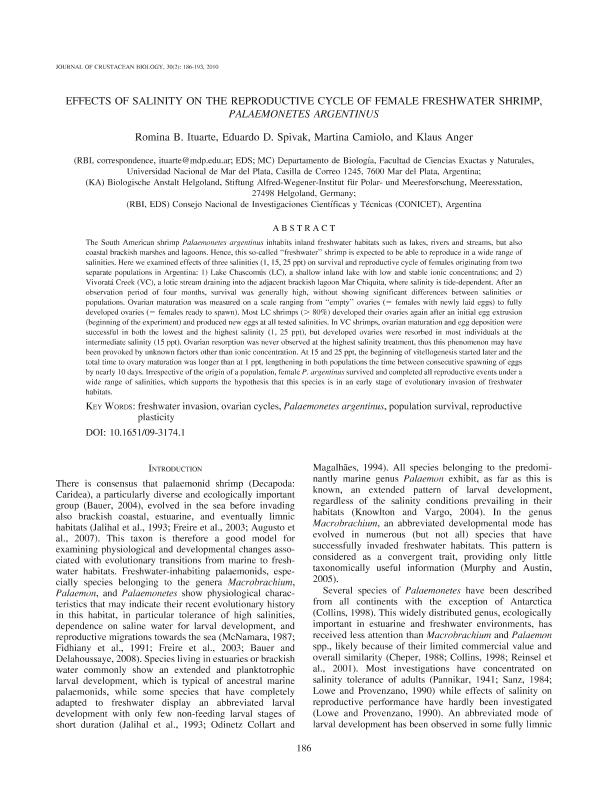Mostrar el registro sencillo del ítem
dc.contributor.author
Ituarte, Romina Belen

dc.contributor.author
Spivak, Eduardo Daniel

dc.contributor.author
Camiolo, Martina Daniela

dc.contributor.author
Anger, Klaus
dc.date.available
2020-03-26T14:19:50Z
dc.date.issued
2010-03
dc.identifier.citation
Ituarte, Romina Belen; Spivak, Eduardo Daniel; Camiolo, Martina Daniela; Anger, Klaus; Effects of salinity on the reproductive cycle of female freshwater shrimp, palaemonetes argentinus; Crustacean Society; Journal of Crustacean Biology; 30; 2; 3-2010; 186-193
dc.identifier.issn
0278-0372
dc.identifier.uri
http://hdl.handle.net/11336/100872
dc.description.abstract
The South American shrimp Palaemonetes argentinus inhabits inland freshwater habitats such as lakes, rivers and streams, but also coastal brackish marshes and lagoons. Hence, this so-called "freshwater" shrimp is expected to be able to reproduce in a wide range of salinities. Here we examined effects of three salinities (1, 15, 25 ppt) on survival and reproductive cycle of females originating from two separate populations in Argentina: 1) Lake Chascoms (LC), a shallow inland lake with low and stable ionic concentrations; and 2) Vivorat Creek (VC), a lotic stream draining into the adjacent brackish lagoon Mar Chiquita, where salinity is tide-dependent. After an observation period of four months, survival was generally high, without showing significant differences between salinities or populations. Ovarian maturation was measured on a scale ranging from "empty" ovaries ( females with newly laid eggs) to fully developed ovaries ( females ready to spawn). Most LC shrimps (> 80) developed their ovaries again after an initial egg extrusion (beginning of the experiment) and produced new eggs at all tested salinities. In VC shrimps, ovarian maturation and egg deposition were successful in both the lowest and the highest salinity (1, 25 ppt), but developed ovaries were resorbed in most individuals at the intermediate salinity (15 ppt). Ovarian resorption was never observed at the highest salinity treatment, thus this phenomenon may have been provoked by unknown factors other than ionic concentration. At 15 and 25 ppt, the beginning of vitellogenesis started later and the total time to ovary maturation was longer than at 1 ppt, lengthening in both populations the time between consecutive spawning of eggs by nearly 10 days. Irrespective of the origin of a population, female P. argentinus survived and completed all reproductive events under a wide range of salinities, which supports the hypothesis that this species is in an early stage of evolutionary invasion of freshwater habitats. © 2010 The Crustacean Society.
dc.format
application/pdf
dc.language.iso
eng
dc.publisher
Crustacean Society

dc.rights
info:eu-repo/semantics/openAccess
dc.rights.uri
https://creativecommons.org/licenses/by-nc-sa/2.5/ar/
dc.subject
FRESHWATER INVASION
dc.subject
OVARIAN CYCLES
dc.subject
PALAEMONETES ARGENTINUS
dc.subject
POPULATION SURVIVAL
dc.subject
REPRODUCTIVE PLASTICITY
dc.subject.classification
Biología Marina, Limnología

dc.subject.classification
Ciencias Biológicas

dc.subject.classification
CIENCIAS NATURALES Y EXACTAS

dc.title
Effects of salinity on the reproductive cycle of female freshwater shrimp, palaemonetes argentinus
dc.type
info:eu-repo/semantics/article
dc.type
info:ar-repo/semantics/artículo
dc.type
info:eu-repo/semantics/publishedVersion
dc.date.updated
2020-01-28T15:01:11Z
dc.journal.volume
30
dc.journal.number
2
dc.journal.pagination
186-193
dc.journal.pais
Estados Unidos

dc.journal.ciudad
Lawrence
dc.description.fil
Fil: Ituarte, Romina Belen. Universidad Nacional de Mar del Plata. Facultad de Ciencias Exactas y Naturales. Departamento de Biología; Argentina. Consejo Nacional de Investigaciones Científicas y Técnicas. Centro Científico Tecnológico Conicet - Mar del Plata; Argentina
dc.description.fil
Fil: Spivak, Eduardo Daniel. Consejo Nacional de Investigaciones Científicas y Técnicas. Centro Científico Tecnológico Conicet - Mar del Plata; Argentina. Universidad Nacional de Mar del Plata. Facultad de Ciencias Exactas y Naturales. Departamento de Biología; Argentina
dc.description.fil
Fil: Camiolo, Martina Daniela. Universidad Nacional de Mar del Plata. Facultad de Ciencias Exactas y Naturales. Departamento de Biología; Argentina. Consejo Nacional de Investigaciones Científicas y Técnicas. Centro Científico Tecnológico Conicet - Mar del Plata; Argentina
dc.description.fil
Fil: Anger, Klaus. Institut fur Polar und Meeresforschung; Alemania
dc.journal.title
Journal of Crustacean Biology

dc.relation.alternativeid
info:eu-repo/semantics/altIdentifier/doi/http://dx.doi.org/10.1651/09-3174.1
dc.relation.alternativeid
info:eu-repo/semantics/altIdentifier/url/https://academic.oup.com/jcb/article/30/2/186/2419226
Archivos asociados
